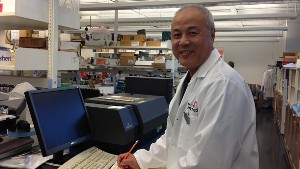Jul 25 2014
Over half of patients being seen in the clinic for a diagnosed brain tumor have metastatic cancer, which has no treatment and detrimental outcomes in most cases.
However, a new Cincinnati Cancer Center (CCC) study, published in the advance online edition of the journal Oncotarget, provides hope that previously studied SapC-DOPS could be used for treatment of brain cancer that has spread.
 Xiaoyang Qi, PhD
Xiaoyang Qi, PhD
Xiaoyang Qi, PhD, member of the CCC, associate director and associate professor in the division of hematology oncology at the University of Cincinnati (UC) College of Medicine and a member of the UC Cancer and Neuroscience Institutes and the Brain Tumor Center, says this critical data shows promise for finding treatment for one of the deadliest cancers.
A lysosomal protein saposin C (SapC), and a phospholipid, known as dioleoylphosphatidylserine (DOPS), can be combined and assembled into tiny cavities, or nanovesicles, to target and kill many forms of cancer cells.
Lysosomes are membrane-enclosed organelles that contain enzymes capable of breaking down all types of biological components; phospholipids are major components of all cell membranes and form lipid bilayers—or cell membranes.
Qi says his lab and collaborators have previously found that the combination of these two natural cellular components, called SapC-DOPS, caused cell death in cancer cell types, including brain, lung, skin, prostate, blood, breast and pancreatic cancer, while sparing normal cells and tissues.
"In spite of significant advances in understanding of the biology of tumors in the body, the translation of this knowledge to new and effective therapeutic strategies has been slow,” he says. "As a consequence, brain tumors, either primary—known as glioblastoma multiforme, the most aggressive and prevalent malignant brain tumor—or secondary (metastatic), remain among the most untreatable and fatal of all cancers.”
He adds that brain metastases arising from primary lung, skin and breast cancers affect about 10 to 30 percent of adult cancer patients and are much more prevalent than primary brain tumors.
"Although new targeted therapies are showing promising results, the difficulty in diagnosing and effectively targeting micrometastases—multifocal small tumors that form as a result of the primary tumor—makes the treatment of brain metastases one of the most pressing challenges in clinical oncology,” Qi says, adding that it’s often hard to both image the smaller tumors and to operate on them. "In this study, we evaluated the ability of SapC-DOPS to selectively target brain metastases of human breast and lung cancer cells in cultures and in animal models.”
Using two groups of models—one injected with a placebo and the other injected with SapC-DOPS—researchers found that those receiving treatment with the nanovesicles had an extended life. Within the animal models, two were completely cured from the brain tumor and resulting metastasis. Scientists were able to monitor the uptake of SapC-DOPS by the tumors and their progression by using immunofluorescence imaging of brain sections.
Within 24 hours of injection, imaging showed that SapC-DOPS targeted the tumors and began to work.
"Because metastatic tumors in these models were generated and did not arise naturally from primary tumors, our models do not represent true metastases. However, they still reiterate the essential steps of the metastatic process,” Qi says. "We were still able to show the antitumor effects of SapC-DOPS on human brain tumor cells in models and that SapC-DOPS selectively targets tumor cells in models with brain micrometastases derived from human breast or lung cancer cells. We also showed that SapC-DOPS has cytotoxic effects on metastatic breast cancer cells in cultures.
"These results support the potential of SapC-DOPS for the diagnosis and therapy of primary and metastatic brain tumors which is critically needed to increase survival rates of patients with this illness.”
This work was supported in part by a pilot grant from the UC Brain Tumor Molecular Therapeutics Program, research funds and hematology oncology programmatic support from the UC College of Medicine, as well as the National Institutes of Health (1R01CA158372), and a New Drug State Key Project grant (009ZX09102-205). Qi is listed as an inventor on the patent for SapC-DOPS technology that is the subject of this research.